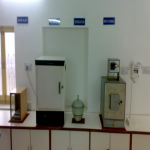

Our Key Strength of LAB :
- Testing capabilities for a variety of agricultural commodities across a wide range of parameters.
- Sophisticated and well-equipped stationary labs at key centres across India.
- Trained and competent quality personnel.
- Techno managers and field personnel are well equipped.
- Labs are equipped with modern equipment, validated techniques and experienced qualified staff.
- Appropriate and recognized certificate quick turnaround time.
Sampling, Analysis & Grading :
The Directorate of Marketing and Inspection functioning under the Agricultural Marketing Adviser to Govt. of India has laid down grade standards for almost all agricultural commodities including processed food articles. These are called the National Grade Specifications which shall be generally adopted in the warehouse for grading the stocks offered for storage. Depending upon the presence of various refractions in the commodities the stocks are graded as I, ll & III Stocks falling below grade III shall not generally be accepted for storage as sound stocks.
Grade specifications like Uniform Grade Specifications are fixed by the Government of India for every crop every year depending upon the condition of each crop and other agro-climatic factors. These grade specifications are uniformly adopted throughout the country for Government procurement operations. The Bureau of Indian Standards (BIS) (erstwhile ISI) also formulates standard specifications for products, equipments materials and processes. BIS covers all industrial items and some food products which are manufactured using industrial processes.
Sampling
For determining the correct grade of the commodity, representative samples shall be drawn. If the sample drawn is not representative of the lot sampled, any amount of care in analysis will not reflect the true quality of the produce. It is, therefore, of vital importance that the sample drawn is representative of the lot to be graded.
Methods of Drawing Sample
All the bags / packages or lots in bulk in a single consignment of the material pertaining to the same variety constitute a lot.
(1) Loose Heap : From a lot, sample might be drawn by inserting hand into the heap up to elbow or more, with the palm upward. The palm should then be cupped with fingers holding tightly together so that the dirt does not strain from the commodity. The arm should be withdrawn slowly. Commodity should be transferred into a sample bag. Such sarnples should be taken out from different sides and depths. A required quantity of four kgs should be collected. This should be mixed thoroughly to ensure a homogeneous mixture. From this, four samples should be made each weighing at least one kilogram by halving and quartering the original sample. Out of these four samples one should be retained at warehouse for future reference. Each lot should be separately sampled. Generally, in a warehouse, no loose grain is accepted.
(2) Bins- Samples should be drawn of different depths with the help of a probe sampler. The small quantity samples so drawn should be mixed together to obtain a composite sample of a lot not exceeding four kgs.
(3) Bagged / Packed commodities : Samples may be taken with a sampler (Parkhi) or by inserting hand or by means of a long scoop after cutting open the seams. An equal number of scoops should be taken out from the top and center of the packages. The quantity of sample drawn from each bag should not exceed 250 Gms. The sample so drawn should be thoroughly mixed and from this composite mixture, four samples weighing about one kilogram each should be taken by halving and quartering the original sample
(4) Stocks,particularly food grains, are required to be examined at periodical intervals, at least once in a fortnight in order to assess the general condition and insect infestation, if any. While categorization enables the Warehouse supervisor / manager & Inspecting Officer to evaluate the condition of stocks, classification aids in adopting timely disinfestations measures. The categorization in respect of important cereals and pulses may vary slightly.
(5) Classification of stocks is done by drawing a representative sample from each lot / stack, sieving the sample vigorously and by assessing the type and intensity of insect infestation. The stocks are then classified as under:
(6) While counting the insects all the stages are to be taken into account, irrespective of whether the insects are major or minor in nature
| Sr.No | Particulars | Class |
| 1. | when there is no live infestation at all | Clear |
| 2. | when there are up to 2 insects per kg. sample | Few |
| 3. | When there are more than two insects per kg. sample | Heavy |



